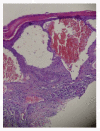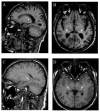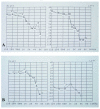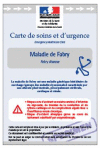Fabry disease
- PMID: 21092187
- PMCID: PMC3009617
- DOI: 10.1186/1750-1172-5-30
Fabry disease
Abstract
Fabry disease (FD) is a progressive, X-linked inherited disorder of glycosphingolipid metabolism due to deficient or absent lysosomal α-galactosidase A activity. FD is pan-ethnic and the reported annual incidence of 1 in 100,000 may underestimate the true prevalence of the disease. Classically affected hemizygous males, with no residual α-galactosidase A activity may display all the characteristic neurological (pain), cutaneous (angiokeratoma), renal (proteinuria, kidney failure), cardiovascular (cardiomyopathy, arrhythmia), cochleo-vestibular and cerebrovascular (transient ischemic attacks, strokes) signs of the disease while heterozygous females have symptoms ranging from very mild to severe. Deficient activity of lysosomal α-galactosidase A results in progressive accumulation of globotriaosylceramide within lysosomes, believed to trigger a cascade of cellular events. Demonstration of marked α-galactosidase A deficiency is the definitive method for the diagnosis of hemizygous males. Enzyme analysis may occasionnally help to detect heterozygotes but is often inconclusive due to random X-chromosomal inactivation so that molecular testing (genotyping) of females is mandatory. In childhood, other possible causes of pain such as rheumatoid arthritis and 'growing pains' must be ruled out. In adulthood, multiple sclerosis is sometimes considered. Prenatal diagnosis, available by determination of enzyme activity or DNA testing in chorionic villi or cultured amniotic cells is, for ethical reasons, only considered in male fetuses. Pre-implantation diagnosis is possible. The existence of atypical variants and the availability of a specific therapy singularly complicate genetic counseling. A disease-specific therapeutic option - enzyme replacement therapy using recombinant human α-galactosidase A - has been recently introduced and its long term outcome is currently still being investigated. Conventional management consists of pain relief with analgesic drugs, nephroprotection (angiotensin converting enzyme inhibitors and angiotensin receptors blockers) and antiarrhythmic agents, whereas dialysis or renal transplantation are available for patients experiencing end-stage renal failure. With age, progressive damage to vital organ systems develops and at some point, organs may start to fail in functioning. End-stage renal disease and life-threatening cardiovascular or cerebrovascular complications limit life-expectancy of untreated males and females with reductions of 20 and 10 years, respectively, as compared to the general population. While there is increasing evidence that long-term enzyme therapy can halt disease progression, the importance of adjunctive therapies should be emphasized and the possibility of developing an oral therapy drives research forward into active site specific chaperones.
Figures
































References
-
- Anderson W. A case of "Angeio-keratoma". Br J Dermatol. 1898;10:113–117. doi: 10.1111/j.1365-2133.1898.tb16317.x. - DOI
-
- Fabry J. Ein Beitrag zur Kenntnis der Purpura haemorragica nodularis (Purpura papulosa hemorrhagica Hebrae) Arch Dermatol Syphilol. 1898;43:187–200. doi: 10.1007/BF01986897. - DOI
-
- Sweeley CC, Klionsky B. Fabry's disease: classification as a sphingolipidosis and partial characterization of a novel glycolipid. J Biol Chem. 1963;238:3148–3150. - PubMed
Publication types
MeSH terms
Substances
LinkOut - more resources
Full Text Sources
Other Literature Sources
Medical

